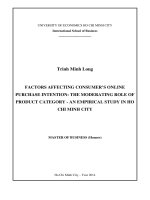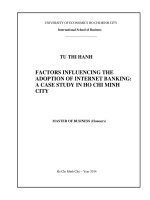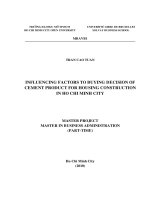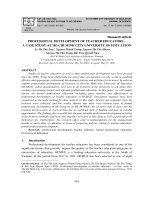Factors influencing the adoption of internet banking a case study in ho chi minh city
Bạn đang xem bản rút gọn của tài liệu. Xem và tải ngay bản đầy đủ của tài liệu tại đây (1 MB, 98 trang )
UNIVERSITY OF ECONOMICS HO CHI MINH CITY
International School of Business
------------------------------
TU THI HANH
FACTORS INFLUENCING THE
ADOPTION OF INTERNET BANKING:
A CASE STUDY IN HO CHI MINH
CITY
MASTER OF BUSINESS (Honours)
Ho Chi Minh City – Year 2014
UNIVERSITY OF ECONOMICS HO CHI MINH CITY
International School of Business
------------------------------
TU THI HANH
FACTORS INFLUENCING THE
ADOPTION OF INTERNET BANKING:
A CASE STUDY IN HO CHI MINH
CITY
ID: 22110018
MASTER OF BUSINESS (Honours)
SUPERVISOR: PHAM QUOC HUNG
Ho Chi Minh City – Year 2014
TABLE OF CONTENTS
ABSTRACT……………………………………………………………………………1
CHAPTER 1: INTRODUCTION ............................................................................... 2
1.1 Background to the study ....................................................................................... 2
1.2 The advantages of electronic banking services ...................................................... 4
1.3 Difficulties in implementing internet banking service ........................................... 4
1.4 Problem statement ................................................................................................ 5
1.4.1 Potential factors can improve the development of electronic banking services ... 5
1.4.2 The reality of electronic banking using and problem statement ......................... 7
1.5 Research objective ................................................................................................ 8
1.6 Limitation ............................................................................................................. 8
1.7 Implication ........................................................................................................... 8
1.8 Structure of Thesis ................................................................................................ 9
1.9 Summary ............................................................................................................ 10
CHAPTER 2: LITERATURE REVIEW AND HYPOTHESES ................................ 11
2.1 The relevant theories ........................................................................................... 11
2.1.1 The theory of reasoned action .......................................................................... 11
2.1.2 Theory of planned behaviour ........................................................................... 13
2.1.3 Technology acceptance model ......................................................................... 14
2.2 Research model and hypotheses .......................................................................... 16
2.2.1 Perceived usefulness ........................................................................................ 16
2.2.2 Perceived ease of use and perceived behavioural control ................................. 18
2.2.3 Subjective norm and attitude ............................................................................ 19
2.2.4 The moderating role of perceived behavioral control ....................................... 20
CHAPTER 3: METHODOLOGY ............................................................................ 22
3.1 Research Design. ................................................................................................ 22
3.2 Questionnaire development ................................................................................. 23
3.2.1 Measurement scales ......................................................................................... 23
3.2.1.1 Measurement of perceived usefulness and perceived ease of use ................... 23
3.2.1.2 Measurement of attitude ................................................................................ 24
3.2.1.3 Measurement of subjective norm .................................................................. 25
3.2.1.4 Measurement of perceived behavioural control ............................................. 26
3.2.1.5 Measurement of intention to use internet banking ........................................ 26
3.2.2 Building questionnaire ..................................................................................... 26
3.3 Description of the pilot study .............................................................................. 27
3.4 The sample ......................................................................................................... 28
3.5 Methods of data analysis ..................................................................................... 29
3.5.1 Reliability ........................................................................................................ 29
3.5.2 Exploratory factor analysis............................................................................... 29
3.5.3 Regression analysis .......................................................................................... 30
3.5.3.1 The Path model ............................................................................................ 30
3.5.3.2 Simple linear regression and multiple linear regression ................................. 31
3.6 Chapter summary ................................................................................................ 32
CHAPTER 4: DATA ANALYSIS AND RESULTS ................................................. 33
4.1 Descriptive analysis ............................................................................................ 33
4.2 Measure scale assessment ................................................................................... 33
4.2.1 Reliability analysis ........................................................................................... 33
4.2.1.1 Reliability analysis for perceived usefulness ................................................. 33
4.2.1.2 Reliability analysis for perceived ease of use ................................................ 34
4.2.1.3 Reliability analysis for attitude ...................................................................... 34
4.2.1.4 Reliability analysis for subjective norm ....................................................... 34
4.2.1.5 Reliability analysis for perceived behavioural control ................................... 35
4.2.1.6 Reliability analysis for intention to use internet banking ............................... 35
4.2.2 Exploratory factor analysis............................................................................... 35
4.2.2.1 Condition for exploratory factor analysis ..................................................... 35
4.2.2.2 Results of exploratory factor analysis ............................................................ 36
4.3 Testing the hypothesis ........................................................................................ 37
4.3.1 Regression Model 1 ......................................................................................... 37
4.3.2 Regression Model 2 ......................................................................................... 38
4.3.3 Regression Model 3 ......................................................................................... 40
4.3.4 Regression Model 4 ......................................................................................... 40
4.3.4.1 Solving the moderator ................................................................................... 40
4.3.4.2 Analysis result .............................................................................................. 41
CHAPTER 5: CONCLUSION .................................................................................. 44
5.1 Overview ............................................................................................................ 44
5.2 Main findings ..................................................................................................... 44
5.3 Practical implications .......................................................................................... 45
5.4 Limitations ......................................................................................................... 46
REFERENCES ......................................................................................................... 46
APPENDIX ............................................................................................................. 48
APPENDIX 1 ........................................................................................................... 54
APPENDIX 2 ........................................................................................................... 59
APPENDIX 3 ........................................................................................................... 62
APPENDIX 4 ........................................................................................................... 64
APPENDIX 9 ........................................................................................................... 65
APPENDIX 6 ........................................................................................................... 66
APPENDIX 7 ........................................................................................................... 69
APPENDIX 9 ........................................................................................................... 74
APPENDIX 9 ........................................................................................................... 78
ABSTRACT
Vietnam economy and bank system had to face many difficulties in 2011 and
2012. This challenge opens a new trend for banks. Electronic banking is a modern service
that banks armed to gain market and improve profit. Since, many financial institutions are
fostering to provide many banking services to customers via the mobile phone, computers
that are connected internet. Financial transactions are conducted via electronic banking
have lower cost and faster speed than physical transactions. However, the number of
people who decide to adopt and use such technologies is still low, particularly in Ho Chi
Minh City. Hence, there is a need to identify relevant factors that influence the adoption
and usage of Internet banking in HCMC. Technology Acceptance Model (TAM) and
Technology of Planed Behaviour (TPB) are two basic models to investigate the adoption
and usage of Internet banking. This research proposes the model that comprises five
variables: Perceived usefulness, Perceived ease of use, Attitude, Subjective norm and
Perceived behavioural control. The results reveal that Perceived usefulness, Perceived
ease to use, Attitude, Subjective norm and Perceived behavioural control have a
significant association with the adoption and usage of Internet banking. The research
result has been a finding so that based on it, leaders of commercial banks will make an
effective strategy to enhance customer satisfaction and improve operational efficiency.
Contributions of this study are a basis for researchers, students for developing
further research to practical applications.
Key words: Perceived usefulness, Perceived ease of use, Attitude, Subjective
norm and Perceived behavioural control, Intention to use.
1
CHAPTER 1: INTRODUCTION
1.1 Background to the Study
Banks are important in every country and have a significant effect in supporting
economic development through efficient financial services. They provide a mechanical
system to group saving and convert them into investment. For over a decade, banks
have been affected by changes associated with globalization and financial
liberalization. Reacting to these changes, banks expand the choice of services
offered to the customers and increase their reliance on technology (Al-Smadi and AlWabel, 2011).
Banks have been significantly affected by the evaluation of technology;
competition between banks has forced them to find new market to expand, and the
number of financial institutions that offer electronic banking products increased. Hence,
banks have begun to offer electronic banking services to improve the effectiveness
of distribution channels through reducing the transaction cost and increasing the
speed of services.
The definition of electronic banking varies among researchers, because electronic
banking refers to types of services through which bank customers can request information
and carry out most retail banking services via computer, television or mobile phone
(Daniel, 1999). Electronic banking is referred to as using of internet as delivery mode for
the provision of services like opening a deposit account, electronic bill payments, and
2
online transfers. These services can either be provided by the banks having physical
offices and by creating a website and providing services through that or services can be
provisioned through a virtual bank as well (Sana haider sumra, 2011). Recently,
electronic banking has become the way for the development of banking system, and the
role of electronic banking is increasing in many countries. It offers opportunities to
create services processes that demand few internal resources, and therefore, lower cost.
As well as it provides wider availability and possibility to reach more customers.
From the customers' point of view, electronic banking allows customers easier
access to financial services and time saving in managing their finance (Almazari and
Siam, 2008; Ayrga, 2011; Tan and Teo, 2000). Indeed, the emergence of electronic
banking has prompted many banks to develop marketing and information technology
strategies in order to stay competitive. Venkatesh, Morris, and Davis (2003) noted that
the successful implementation of information systems is dependent on the extent to
which such a system is used and eventually adapted by the potential users.
Information system implementation is not likely to be considered successful if users
are unmotivated to use that type of technology, and thus it will not bring full benefits to
the organization. In order to motivate customers to use electronic banking, banks must
make key improvements that address the customers' concerns.
Although Internet banking introduces many benefits for banks and customers;
customers still fear from the risk of electronic banking services. Some customers feel
that Internet banking services could make them lose their money. Hence, there are still
a large group of customers who refuse to adopt such services (Kuisma, Laukkanen, and
3
Hiltunen, 2007; Littler and Melanthiou, 2006; Natarajan, Balasubramanian, and
Manickavasagam, 2010). Without understanding what motivates the customers to use
Internet banking services, banks will not be able to take actions to increase the use of
such services. Therefore, it is necessary to understand the key factors that influence
the adoption of electronic banking among the banking customers.
1.2 The Advantages of Electronic Banking Services:
Electronic banking services have many benefits for both banks and customers.
From the customers’ point of view, Aladwani (2001), found that electronic banking
provide faster, easier and more reliable services to customers. Payment services through
Internet banking, customers can conduct banking transactions do not need go to the bank,
not restricted by geographical area. They can sit at home to ordering, purchase a variety
of goods and services quickly. Those services help customer saving time and costs.
For banks, Internet banking is conceded a strategy weapon; help them to achieve
competitive advantage and increase their market share. Furthermore, using Internet
services can save the cost of resources, which are needed for traditional baking services
(Jayawardhena and Foley, 2000).
The number of individual customers using the internet and online payment via the
internet is increasing. In particular, the young customers can adaptable easily the new
information technology. The commercial banks also save operating costs in counting and
storage of cash.
1.3 Difficulties in Implementing Internet Banking Service
4
Vietnamese are afraid when dealing online. In particular, a number of Vietnam
enterprises still consider with the payment service via Internet banking, do not have the
habit of Internet banking transactions. Some customers concern about the safety of
payment transactions through Internet banking channels.
Age factor, the older customer has limited to access new technologies and use of
banking services on the computer as well as on mobile phone.
Social factor, the habit of using cash is a major obstacle.
Legal factor, whether Internet transaction law was effect, but crime in this area has
not been discuss in detail.
The commercial banks need to invest in technology and infrastructure for effective
implementation of Internet banking services. Some banks have not invested properly, so
infrastructure cannot meet the demand for payment transactions, sometimes happens the
interrupt of customer transactions.
1.4 Problem Statement
Internet banking is popularly known is the recent trend in banking transition and
holds a bright future that is promising over and above the one brought by Internet
banking. Internet banking provided personalized, anytime - anywhere banking services.
Nevertheless, with all the laudable benefits of Internet banking, it is yet to gain larger
scale adoption, especially in the emerging economies.
1.4.1 Potential Factors Can Improve the Development of Electronic Banking
Services
Proportion of Non-Cash Payment:
5
According to the State Bank of Viet Nam, the rate of cash payment per total means
of payment has declined over 9 years (from 31.6% in 1991 to 11.8% in 2012). This is an
important prerequisite for the development of electronic payment services in Vietnam.
See it more clearly in appendix 3.
The rate of non-cash payment is more and more increasingly. However, both the
proportion and the value of payment with bankcard were still very low when comparing
with other payment means. This rate was 0.2% in total non-cash payment.
The Development of Personal Accounts:
According to Vietnam Bank Card Association, the development of personal
accounts in Vietnam was very high, 124% average growth per year over the period 20062011. At June 30, 2011, the commercial banks have issued 36 million personal accounts,
for 17 million people (about 20% of Vietnam's population).
The Bank Card Market
The bank card, especially the domestic debit card has became a popular payment
mean. It has developed rapidly in recent years. The amount of card that was issued on
june 30th, 2012 got 47.22 million. Especially, the rate of debit card got 94%.
The increasing of bank card became the potential opportunity for bank in
improving the Internet banking services. See it more clearly in 3.
The System of ATM (Automated Teller Machine) and POS (Point of Sale)
The equipment network that served payment through card was improved
obviously. The amount of ATM and POS machine increased considerably. There were
13,920 ATM machines and 89,957 POS machines on june 30th, 2012. See it more clearly
6
in appendix 3.
*The Development of Electric Means:
The amount of mobile phone subscriber and internet user increased quite
regularly, this was a good opportunity for developing electronic banking services through
mobile phone and internet. See it more clearly in appendix 3.
1.4.2 The Reality of Electronic Banking Using and Problem Statement
Although, the developing Internet banking of banks met many advantages, the
outcome of this business activity was still modest. According to the commercial banks
survey of Nielsen Vietnam in August 2011, there are less than 3% banking customers
using Internet banking services. This figure is still very low when compare with
developed nations in Asia. It means that Internet banking service in Vietnam is a
potential market in future. The Internet banking payment market has developed more
strongly. At the end of March 2012, the amount of Internet banking user increased 35%
compared with 2010. However, this improvement was not really corresponding to the
above potential factors of Vietnam, especially in HCMC. Ho Chi Minh City was the area
that held over one-third the financial and monetary activity market share of Vietnam. So,
the above statistics of Vietnam also could represent the statistics of HCMC. The
following figure showed the internet users that used internet to carry out financial
transaction were the lowest level. See it more clearly in appendix 3.
During the last ten years, there was many studies concerning about the adaption
and usage of Internet banking (Chan and Lu, 2004; Jayawardhena and Foley, 2000;
Kolodinsky, Hogarth, and Hilgert, 2004; Pikkarainen, Karjalouto, and Pahnila, 2004;
7
Yiu, Grant, and Edgar, 2007). However, most of these studies focused on the West and
the United States. In contrast, little is written in developing countries (Al-Somali,
Gholami, and Clegg, 2009; Jabnoun and Al-Tamimi, 2003). In Asian region, most
studies concentrated to developed Asian countries (Singapore, Hong Kong, Taiwan,
Malaysia, etc…) than developing countries like Vietnam, Lao, Cambodia.
In Vietnam, Internet banking services are still in the initial stages of development.
Thus, there is a need to study and understand users’ acceptance of Internet banking
services in order to identify the factors affecting the adoption of Internet banking.
As a result, there is a necessity to research about the intention to use Internet
banking in Ho Chi Minh City, Vietnam. The finding of this study can help the marketers
in the banking sector offer more suitable marketing strategies in their field in order to
make higher attractiveness with Internet banking service.
1.5 Research Objective
Specifically the objective of this study is to investigate and validate the factors
influencing the adoption and usage of Internet banking.
The purpose of this study is to investigate and validate the factors influencing the
adoption and usage of Internet banking in Ho Chi Minh City, Vietnam. The study will
investigate these factors by using two different models: Technology Acceptance Model
(TAM) and Theory of Planed Behaviour (TPB). The finding of this research may support
some important information for leaders or marketers in doing their marketing strategies in
banking industry. Marketers may base on these hypotheses to build suitable marketing
plans for customers in Viet Nam.
8
1.6 Limitation
This study is conduct in Ho Chi Minh City, one of the biggest economic centers of
Vietnam. The research object is the customers who are using the bank account, has
registered to use Internet banking service. Due to limited time and cost, the research
surveyed about 400 customers of banks in HCMC.
The data are collected in Ho Chi Minh City, one of the biggest economic centre of
Viet Nam. However, there are still some differences from other provinces such as culture,
income, knowledge… So, the result of research just can undertake in the Ho Chi Minh
City market.
The research will assess only in the adaption and usage of Internet banking. The
other factors such as the priority in choosing the bank, other services in banking… are out
of the topic of this research.
1.7 Implication
This study has important implications for both practical business (leaders of
commercial banks, marketing managers…) and academic (researchers, students of the
business administration department…) as follow:
The research result has been a finding so that based on it, leaders of commercial
banks will make an effective strategy to enhance customer satisfaction and improve
operational efficiency. Marketing managers will consider to set up an appropriate
communicate strategy.
The results of this study are a basis for researchers, students for developing further
research to practical applications.
9
1.8 Structure of Thesis
This thesis concludes five chapters.
Chapter 1 provides an introduction to Internet banking services and sets out the objective
and significance of this research.
Chapter 2 literature review and hypotheses.
Chapter 3 methodology.
Chapter 4 data analysis and results.
Chapter 5 conclusion.
1.9 Summary
The thesis begins the introduction by discussing the research background and
importance of Internet banking in business and banking industry. Then the problem
statement was defined to take a closed look at using electronic banking in Viet Nam.
Finally, this chapter discussed the research implications. The most important
thing to remember is that Internet banking provide vast amount of opportunities to the
commercial banks and customers. This is a fact acknowledged all over the world, and not
the least in HCMC where mobile usage and computer technology in general are very
popular.
10
CHAPTER 2: LITERATURE REVIEW AND HYPOTHESES
2.1 The Relevant Theories
2.1.1 The Theory of Reasoned Action (TRA)
The Theory of Reasoned Action (Ajzen, 1975) posits that individual behaviour is
driven by behavioural intentions where behavioural intentions are a function of an
individual's attitude toward the behaviour and subjective norms surrounding the
performance of the behavior: Behavioural Intention = Attitude + Subjective Norm. In
short, if a person's attitude and subjective norms are known, the behavioural intention can
be predicted.
Figure 7: Theory of Reasoned Action
Attitude toward the behaviour is defined as the individual's positive or negative
feelings about performing a behaviour.
Subjective norm is defined as an individual's perception of whether people
important to the individual think the behaviour should be performed.
Theory of Reasoned Action suggests that a person's behaviour is determined by his/her
11
intention to perform the behaviour and that this intention is, in turn, a function of his/her
attitude toward the behaviour and his/her subjective norm. The best predictor of
behaviour is intention. Intention is the cognitive representation of a person's readiness to
perform a given behaviour, and it is considered to be the immediate antecedent of
behaviour. This intention is determined by three things: their attitude toward the specific
behaviour, their subjective norms and their perceived behavioural control. The theory of
planned behaviour holds that only specific attitudes toward the behaviour in question can
be expected to predict that behaviour. In addition to measuring attitudes toward the
behaviour, we also need to measure people’s subjective norms – their beliefs about how
people they care about will view the behaviour in question. To predict someone’s
intentions, knowing these beliefs can be as important as knowing the person’s attitudes.
Finally, perceived behavioural control influences intentions. Perceived behavioural
control refers to people's perceptions of their ability to perform a given behaviour. These
predictors lead to intention. A general rule, the more favourable the attitude and the
subjective norm, and the greater the perceived control the stronger should the person’s
intention to perform the behaviour in question.
The model has some limitations including a significant risk of confounding
between attitudes and norms since attitudes can often be reframed as norms and vice
versa. A second limitation is the assumption that when someone forms an intention to act,
they will be free to act without limitation. In practice, constraints such as limited ability,
time, environmental or organisational limits, and unconscious habits will limit the
freedom to act. TPB attempts to resolve this limitation.
12
2.1.2 Theory of Planned Behaviour (TPB)
The theory of planned behaviour (TPB) was developed by Ajzen in 1988. The
theory proposes a model which can measure how human actions are guided. It predicts
the occurrence of a particular behaviour, provided that behaviour is intentional. The
theory of planned behaviour extended the theory of reasoned action to explain
behavioural conditions not entirely under volitional control, and stressed the influence of
attitude, subjective norms and perceived behavioural control beliefs on behavioural
intention and actual usage. It was also used by Liao et al. (1999) in the context of virtual
banking adoption and only partially explained the relationships.
The model is out lined in the next figure and represents the three variables which
the theory suggests will predict the intention to perform a behaviour. The intentions are
the precursors of behaviour Ajzen and Fishbein formulated in 1980 the theory of
reasoned action (TRA). This resulted from attitude research from the Expectancy Value
Models. Ajzen and Fishbein formulated the TRA after trying to estimate the discrepancy
between attitude and behaviour.
This TRA was related to voluntary behaviour. Later on behaviour appeared not to
be 100% voluntary and under control, this resulted in the addition of perceived
behavioural control. With this addition the theory was called the theory of planned
behaviour (TPB).
Because behaviour can be deliberative and planned, the theory of planned
behaviour is a theory which predicts deliberate behaviour.
13
Figure 8: The Theory of Planned Behaviour
The variable names in the model reflect psychological constructs and so they have
the meaning within the theory.
2.1.3 Technology Acceptance Model (TAM)
The Technology Acceptance Model, developed by Davis, Bagozzi and Warshaw
(Davis 1989; Davis et al. 1989), replaced the attitude measures of Fishbein and Ajzen's
theory with two technology acceptance measures: perceived ease of use and perceived
usefulness.
Perceived usefulness is defined as the degree to which a person believes that the
use of a system will improve his performance. Perceived ease of use refers to the degree
to which a person believes that the use of a system will be effortless. The term 'external
variables' is used to describe all system design features which have a direct influence on
perceived usefulness and perceived ease of use. Similar to the Theory of Reasoned
Action, users' perceptions determine the attitude towards using the information system.
This attitude determines the intention to use, which in turn leads to actual system use.
Figure 9 shows an overview of the Model. According to Dishaw and Strong (1999), there
14
are two key differences between the Model and the theory of reasoned action. The first
defines perceived ease of use and perceived usefulness as external variables to determine
the intended use rather than the actual use. The Model also does not include subjective
norms. Lin (2007), based on data from Taiwanese online bookstores, gives an empirical
comparison of the theory of reasoned action with the theory of planned behaviour in
regard to aptness of explaining consumer intentions to shop online. The theory of planned
behaviour extended the theory of reasoned action to explain behavioural conditions not
entirely under volitional control, and stressed the influence of attitude, subjective norms
and perceived behavioural control beliefs on behavioural intention and actual usage. It
was also used by Liao et al. (1999) in the context of virtual banking adoption and only
partially explained the relationships.
Figure 9: Technology Model Acceptance by Davis et al. (1989)
2.2 Research Model and Hypotheses
15
The Proposed Research Model
Based on the theoretical models developed, this research proposes the above
model with regard to the adoption of internet banking. This model shows the relationship
between intention to use and fives components including perceived usefulness, perceived
ease to use, attitude, subjective norm and perceived behavioural control. In this proposed
model, attitude towards using internet banking mediates the relationship between four
variables: Perceived usefulness, perceived ease of use, subjective norm and intention to
use.
2.2.1 Perceived Usefulness (PU)
Perceived usefulness is defined as “the degree to which a person believes that
using a particular system would enhance his or her job performance” (Davis, 1989, p.
320). In general, when the users found that the system is useful for them, then they will
have the intention to use it and lead to the actual usage of the system. Based on previous
16
research using the TAM model, it is found that perceived usefulness is the primary
antecedent that determines the behavioural intention (Davis, 1989; Venkatesh & Davis,
2000).
Furthermore, the perceived usefulness was found to significantly predict
perceived behavioural control in term of electronic services (Horst et al., 2007). So, this
research hypothesizes the following hypothesis:
H3a: Perceived usefulness positively related to perceived behavioural control.
Finally, Davis (1989) has supported that the cognitive dimension includes
perceived usefulness and perceived ease of use and they are the most important factors
influencing attitudes. Perceived usefulness and perceived ease of use affect a user's
attitude about the use of a new technology. So, the hypothesis shows the relationship
between perceived usefulness and attitude is proposed:
H1a: Perceived usefulness positively related to attitudes towards the use of internet
banking
Actually, Internet banking product that gives by banks always has its usefulness.
However, when customer perceives it usefulness or think that its utilities can enhance
customer’s job performance they will have a positive feeling. The feeling about job
performance is also customer’s attitude towards using Internet banking.
In my own opinion, perceiving the Internet banking’s usefulness can improve the
Perceived behavioural control. Because, when Internet banking can enhance the job
17
performance, customer will try to fulfill their ability to use Internet banking proficiency.
So, perceived usefulness has a positive relationship with Perceived behavioural control.
2.2.2 Perceived Ease of Use (PEOU) and Perceived Behavioural Control (PBC)
Perceived ease of use is defined as “the degree to which a person believes that
using a particular system would be free from effort” (Davis, 1989, p. 323). All else being
equal, an application perceived to be easier to use is more likely to be accepted by the
users (Davis, 1989). A considerable of prior studies supported the significant effect of
perceived ease of use on behavioral intention, either directly or indirectly through
perceived usefulness and attitude (e.g., Davis et al., 1989; Jackson et al., 1997;
Venkatesh, 1999). This study seeks to reuse such relationships in the context of internet
banking. Accordingly, this research hypothesizes that:
H1b: Perceived ease of use positively related to attitudes towards the adoption and
usage of internet banking
One more important definition is perceived behavioural control, which reflects
perceptions of internal and external constraints on behavioural (Ajzen 1985, 1991).
Otherwise, perceived behavioural control mentions people's perceptions of their ability to
perform a given behavior. Most studies find a positive effect of perceived behavioral
control (PBC) on behavioral intentions. In addition, Pavlou (2006) indicate that the
perceived ease of use of searching for online information and making an online purchase
correlates highly with the PBC of both behaviors (r = .43, r = .52, respectively). Other
18
researchers similarly reveal strong correlations between PEOU and PBC (Yi et al. 2005).
Based on above theories, this study shows the following hypothesis:
H3b: Perceived ease of use positively related to perceived behavioral control toward the
adoption and usage of internet banking
There is also some discussions about two hypothesizes. When customers think
Internet banking is simple and easy to use with them, they will improve their
performance by using IB. Hence, the higher perceived ease of use, the higher level of
Perceived behavioral control and attitude towards intention to use IB.
2.2.3 Subjective Norm and Attitude
Subjective norm reflects perceptions that significant referents desire the individual
to perform or not perform a behavior (Fishbein and Ajzen, 1975). In another words,
subjective norm also gives an individual's perception of whether people important to the
individual think the behaviour should be performed. Hee Sun Park (2000) found that
attitudes and subjective norms have a significant relationship. Besides, Attitude toward
the behaviour is defined as the individual's positive or negative feelings about performing
a behaviour (Ajzen, 1975). Attitude toward behavior refers to the degree to which a
person has a favourable or unfavourable evaluation or appraisal of the behavior in
question (Ajzen, 1991, p.188). Attitude towards usage reflects feelings of favourableness
or unfavourableness towards using the technology (Taylor and Todd, 1995). The TPB
declares that behavior is a direct function of behavioural intention and perceived
19









